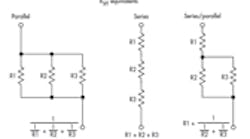Fine-Tune Resistance In Precision Circuits Without Costly Components
Three network topologies
Typical assortment of 70 resistors
The “trimpot” is the standard solution to the analog designer’s occasional need to fine-tune a resistance in a precision circuit. But this old standby isn’t always available. For example, in some aerospace applications such as planetary exploration, mechanical trimmers may be unsuited to the vibration, acceleration, vacuum, temperature extremes, and ultra-high-reliability requirements of space flight.
An obvious workaround would be to temporarily install trimmers and use them to calibrate circuit function in the usual way. You could then remove, measure, and replace the trimmers with flight-qualified fixed resistors that match the measured selected-in-test (SIT) resistances in final assembly.
There’s a catch, however. The same costly and time-consuming screening, testing, and documentation requirements of space flight component qualification that excluded trimpots apply to fixed resistors, too. Consequently, each separate resistor value included in any flight hardware assembly represents a very expensive and long lead-time line item.
Budgetary and time restrictions, therefore, place Draconian limits on the number of different resistors that can be stocked or ordered to implement SIT resistances. So, it can be impractical to directly replace measured SIT resistances with matched-value flight-qualified fixed resistors.
Fortunately, a more cost-effective alternative exists. The scheme involves replacing trimmers not with single, fixed resistors, but with networks consisting of triads of fixed resistors. This technique was used in the Tunable-Diode Laser Spectrometer (TLS) at the Jet Propulsion Laboratory at Caltech in Pasadena, Calif. The TLS is part of the Sample Analysis on Mars science instrumentation package of the Mars Science Laboratory rover.
The resistors in each triad are selected from a relatively small—and, thus, more economical—assortment (for example, 70) of fixed resistors plus open (1012 Ω) and short (10–3 Ω) values. The key to the technique is an exhaustive search algorithm that chooses the resistors for the triad from the assortment so the triad can create the equivalent (Thévenin) resistance desired within about 0.1% of the target value over more than five decades (from less than 10 Ω to more than 1 MΩ).
Designers can use three different network topologies (see the figure), depending on the general range of the RSIT resistance: parallel for RSIT < 500 Ω, series for RSIT > 25 kΩ, and series/parallel (500 Ω < RSIT < 25 kΩ). A simple and small but exhaustive (brute force = N3) search computer algorithm chooses the best-fit resistor values from the supplied inventory of resistor values. The table shows a typical assortment of 70 resistors.
